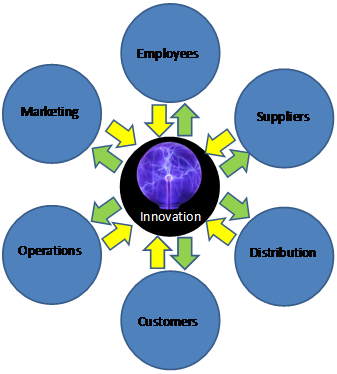 Innovation is about change. Companies that successfully innovate in a repeatable fashion have one thing in common – they are good at managing change. Now, change comes from many sources, but when it comes to innovation, the main sources are incremental innovation and disruptive innovation.
Innovation is about change. Companies that successfully innovate in a repeatable fashion have one thing in common – they are good at managing change. Now, change comes from many sources, but when it comes to innovation, the main sources are incremental innovation and disruptive innovation.
The small changes from incremental innovation often come from the realm of implementation, so the organization, customers, and other stakeholders can generally adapt. However, the large changes generated by disruptive innovation, often come from the imagination, and so these leaps forward for the business often disrupt not only the market but the internal workings of the organization as well – they also require a lot of explanation.
The change injected into organizations by innovation ebbs and flows across the whole organization’s ecosystem:

Let’s explore the change categories visualized in this framework using the Apple iPod as an example:
Changes for customers – Any disruptive innovation requires a company to imagine for the customer something they can then imagine for themselves. Go too far past your customers’ ability to imagine how the new product or service solves a real problem in their lives, and your adoption will languish.
- Customers had to try and imagine Apple as more than a computer hardware manufacturer, and begin to see them as a company to trust for reliable consumer electronics. They also had to imagine what it might mean to download music digitally (without any physical media).
Changes for employees – Disruptive innovations often require employees do things in a new way, and that can be uncomfortable, even if it is only your employees imagining what you are going to ask them to help your customers imagine.
- Employees had to acquire lots of new knowledge and skills. Apple support employees had to learn to support a different, less-technical customer. Other employees had to learn how to effectively build partnerships in the music industry.
Changes for suppliers – Innovations that disrupt the status quo may require suppliers to work with you in new ways. Some disruptive innovations may require suppliers to make drastic changes akin to those they had to make to support just-in-time manufacturing.
- Apple had to work with suppliers to source components at the higher volumes and shorter lead times required for success in consumer electronics. This meant finding some new suppliers who could handle the new volumes and market requirements.
Changes in distribution – Often big innovations disrupt whole distribution channels and this can cause challenges for incumbent organizations (think Compaq and big box retailers versus Dell Direct).
- Going into consumer electronics meant that Apple had to build relationships with the big box stores including people like Target, Wal-mart, and Costco. They also had to build a completely new distribution system – iTunes – for distributing digital music.
Changes in marketing – New products and services (especially disruptive ones), can require marketing to find and build relationships with completely different types of customers and/or require marketing to speak to customers in a different way or to reach them through different channels.
- Marketing had to begin moving the brand from computing to lifestyle, including changing the company name from ‘Apple Computer’ to ‘Apple’ in 2007.
- Marketing also had to learn how to connect with mass market consumers, and help them imagine how this new hardware/software combination would enhance their life – no small task.
Changes in operations – In addition to changes in the supply chain, the organization may have to adapt to disruptive innovations by hiring different types of employees, re-training existing employees, accounting for revenue in a different way, or going about production in a new way.
- The Apple iPod was an experience sell, which highlighted the fact that Apple didn’t really have a place where they could help customers experience their products. This led to the opening of Apple retail stores. Apple’s finance and operations had to adapt to the change from low volume, high price items to high volume, low price items. Apple also had to build out a resource-intensive online operation that didn’t exist before (lots of IT investment).
 Note that the chart has arrows going in both directions, but not simultaneously. There is a push-pull relationship. At the beginning of the innovation process the satellites influence what the innovation will look like (new production capabilities, new suppliers, ideas from partners/suppliers, component innovations, new marketing methods, etc.). But as the innovation goes into final commercialization, the direction of the change becomes outwardly focused.
Note that the chart has arrows going in both directions, but not simultaneously. There is a push-pull relationship. At the beginning of the innovation process the satellites influence what the innovation will look like (new production capabilities, new suppliers, ideas from partners/suppliers, component innovations, new marketing methods, etc.). But as the innovation goes into final commercialization, the direction of the change becomes outwardly focused.
You can see that as an organization is imagining how to take their creative idea and transform it into a valuable innovation in the marketplace, they also should be imagining all of the changes that are going to be required and how they will implement them. This is no small feat, but with proper planning, organizational learning, and adaptation over time, any organization can improve its ability to cope with and even anticipate the change necessary to implement its next disruptive innovation.
![]() Sign up here to get Human-Centered Change & Innovation Weekly delivered to your inbox every week.
Sign up here to get Human-Centered Change & Innovation Weekly delivered to your inbox every week.


Agreed 100% and would go further to say that managing change in innovation is different than managing many other types of change.
An exceptional change resilience, nay an appetite is required that must be fostered, built and celebrated inside the organization and with everyone affected (including suppliers and customers). This does not happen by default – not even among the passionate. Everyone is susceptible to change fatigue – and needs rejuvenation and encouragement. Understanding the dynamics and triggering interventions is key (from individual coaching, progress reporting, to celebrating ‘wins’, to discussing the change journey). An holistic and coordinated approach is key. Some organizations have figured out how to “do” this organically others can benefit from support.
Love your blog and read all the time. Please keep it up. Gail
Pingback: Most Companies Fail at Innovation Because… | Innovation Change Management
Pingback: Innovation Excellence | Most Companies Suck at Innovation Because…
Pingback: Most Companies Suck at Innovation Because… | Stikkee Change
Pingback: Making Innovation Sustainable – Part 1 of 4 | Human-Centered Change and Innovation
Pingback: Making Innovation Sustainable – Part 2 of 4 | Human-Centered Change and Innovation
Pingback: Making Innovation Sustainable – Part 3 of 4 | Human-Centered Change and Innovation
Pingback: Making Innovation Sustainable – Part 4 of 4 | Human-Centered Change and Innovation